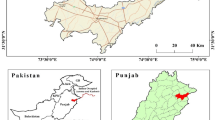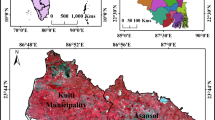Abstract
The consequences of rapid industrialization and urbanization are the conversion of natural surfaces into semi-impervious built-up features. In the context of rapid urbanization, the present work captures the temporally consistent high heat-radiating surface features through the Land Surface Temperature (LST)-derived novel thermal index, called the Spatio Temporal Thermal Consistency Index (STTCI). The index was derived from the time-series Landsat 5 TM and 8 OLI & TIRS data from 1990 to 2010 and from 2015 to 2020, respectively, at the five-yearly interval and applied over the Kolkata Metropolitan Area (KMA). The correlation coefficient between field-collected and image-based LST came to be 0.89 for 2020. The LST results revealed an increasing trend in the mean LST values, i.e., from 19.53 °C to 23.56 °C in the KMA from 1990 to 2020, respectively. The minimum and maximum temperatures also increased about 4 °C and 7 °C, respectively, in this period. The novel STTCI was compared with the selected thermal built-up indices. The results showed that the STTCI outperformed all the other selected thermal built-up indices when correlated with the concerned image-based LST information (r > 0.95). The accuracy values for identifying built-up areas were assessed for all the indices. The STTCI showed the highest accuracy mostly over 90% with kappa values mostly > 0.85. Finally, STTCI-based built-up area extraction was performed and it was estimated that the built-up areas increased from 389.88 sq. Km to 789.57 sq. Km from 1990 to 2020.








Similar content being viewed by others
Data Availability
Some of the generated datasets of the current research are restricted. However, the datasets may be available from the corresponding author on reasonable request.
References
As-syakur, A. R., Adnyana, I. W. S., Arthana, I. W., & Nuarsa, I. W. (2012). Enhanced built-up and bareness index (EBBI) for map** built-up and bare land in an urban area. Remote Sensing. https://doi.org/10.3390/rs4102957
Azmi, R., Alami, O. B., Saadane, A. E., Kacimi, I., & Chafiq, T. (2016). A modified and enhanced normalized built-up index using multispectral and thermal bands. Indian Journal of Science and Technology, 9(28), 1–11.
Bhatta, B. (2009). Analysis of urban growth pattern using remote sensing and GIS: A case study of Kolkata, India. International Journal of Remote Sensing, 30(18), 4733–4746. https://doi.org/10.1080/01431160802651967
Bouhennache, R., Bouden, T., Taleb-Ahmed, A., & Cheddad, A. (2019). A new spectral index for the extraction of built-up land features from Landsat 8 satellite imagery. Geocarto International, 34(14), 1531–1551. https://doi.org/10.1080/10106049.2018.1497094
Carlson, T. N., & Ripley, D. A. (1997). On the relation between NDVI, fractional vegetation cover, and leaf area index. Remote Sensing of Environment, 62(3), 241–252. https://doi.org/10.1016/S0034-4257(97)00104-1
Census of India. (2011). District Census Handbook: Kolkata-Village and Town Wise Primary Census Abstract (PCA): Directorate of Census Operations West Bengal.
Chakraborti, S., Banerjee, A., Sannigrahi, S., Pramanik, S., Maiti, A., & Jha, S. (2019). Assessing the dynamic relationship among land use pattern and land surface temperature: A spatial regression approach. Asian Geographer, 36(2), 93–116. https://doi.org/10.1080/10225706.2019.1623054
Chander, G., Markham, B. L., & Helder, D. L. (2009). Summary of current radiometric calibration coefficients for Landsat MSS, TM, ETM+, and EO-1 ALI sensors. Remote Sensing of Environment, 113(5), 893–903. https://doi.org/10.1016/j.rse.2009.01.007
Chen, Y. C., Chiu, H. W., Su, Y. F., Wu, Y. C., & Cheng, K. S. (2017). Does urbanization increase diurnal land surface temperature variation? Evidence and implications. Landscape and Urban Planning, 157, 247–258. https://doi.org/10.1016/j.landurbplan.2016.06.014
Fluke Corporation. (2022). 62 MAX Mini Infrared Thermometer. Retrieved March 7, 2022, from https://www.fluke.com/en-in/product/temperature-measurement/ir-thermometers/fluke-62-max.
DasGupta, R., & Shaw, R. (2013). Changing perspectives of mangrove management in India—An analytical overview. Ocean & Coastal Management, 80, 107–118. https://doi.org/10.1016/j.ocecoaman.2013.04.010
Foy, B. R., & Theiler, J. (2004). Scene analysis and detection in thermal infrared remote sensing using independent component analysis. In Independent Component Analyses, Wavelets, Unsupervised Smart Sensors, and Neural Networks II (Vol. 5439, pp. 131–139). SPIE. https://doi.org/10.1117/12.542442
Fu, P., & Weng, Q. (2018). Responses of urban heat island in Atlanta to different land-use scenarios. Theoretical and Applied Climatology, 133(1), 123–135. https://doi.org/10.1007/s00704-017-2160-3
Ghosh, S., Chatterjee, N. D., & Dinda, S. (2019). Relation between urban biophysical composition and dynamics of land surface temperature in the Kolkata metropolitan area: A GIS and statistical based analysis for sustainable planning. Modeling Earth Systems and Environment, 5(1), 307–329. https://doi.org/10.1007/s40808-018-0535-9
Huete, A. R. (1988). A soil-adjusted vegetation index (SAVI). Remote Sensing of Environment, 25(3), 295–309. https://doi.org/10.1016/0034-4257(88)90106-X
IPCC. (2021). Climate Change 2021: The Physical Science Basis-Summary for Policymakers Working Group I contribution to the Sixth Assessment Report of the Intergovernmental Panel on Climate Change: WHO & UNEP.
Kumari, P., Yadav, N. K., Santra, A., & Upadhayay, U. (2019). Identification of urban heat islands from multi-temporal MODIS land surface temperature data: A case study of the southern part of West Bengal, India. In A. Singh (Ed.), Wastewater reuse and watershed management (pp. 135–143). Apple Academic Press Inc.
Liu, C., Shao, Z., Chen, M., & Luo, H. (2013). MNDISI: A multi-source composition index for impervious surface area estimation at the individual city scale. Remote Sensing Letters, 4(8), 803–812. https://doi.org/10.1080/2150704X.2013.798710
Rasul, A., Balzter, H., Ibrahim, G. R. F., Hameed, H. M., Wheeler, J., Adamu, B., & Najmaddin, P. M. (2018). Applying Built-Up and Bare-Soil Indices from Landsat 8 to Cities in Dry Climates. Land, 7(3), 81. https://doi.org/10.3390/land7030081
Rouse, J. W., Jr., Haas, R. H., Schell, J. A., & Deering, D. W. (1974). Monitoring vegetation systems in the great plains with erts. NASA Special Publication (Vol. 351, p. 309).
Sahana, M., Hong, H., & Sajjad, H. (2018). Analyzing urban spatial patterns and trend of urban growth using urban sprawl matrix: A study on Kolkata urban agglomeration, India. Science of the Total Environment, 628–629, 1557–1566. https://doi.org/10.1016/j.scitotenv.2018.02.170
Santra, A. (2017). Land surface temperature estimation and urban heat island detection: A remote sensing perspective. In A. Santra & S. S. Mitra (Eds.), Remote sensing techniques and gis applications in earth and environmental studies (pp. 16–45). Hershey, P.A.: IGI Global.
Santra, A., Mitra, S. S., Sinha, S., & Routh, S. (2020). Performance testing of selected spectral indices in automated extraction of impervious built-up surface features using Resourcesat LISS-III image. Arabian Journal of Geosciences, 13(22), 1229. https://doi.org/10.1007/s12517-020-06183-z
Santra, A., Kumar, A., Mitra, S. S., Routh, S., Akashdeep, G., & A., & Harsh, K. (2021a). Assessing the spatio-temporal dynamics of the coal fire in Jharia Coal Field using bi-temporal Landsat images. Indian Journal of Spatial Science, 12(1), 1–10.
Santra, A., Mitra, S. S., Sinha, S., Routh, S., & Kumar, A. (2021b). Identification of impervious built-up surface features using resourcesat-2 LISS-III-based novel optical built-up index. In P. Kumar, H. Sajjad, B. S. Chaudhary, J. S. Rawat, & M. Rani (Eds.), Remote sensing and GIScience: Challenges and future directions (pp. 113–126). Springer International Publishing.
Sekertekin, A., & Bonafoni, S. (2020). Land surface temperature retrieval from landsat 5, 7, and 8 over rural areas: Assessment of different retrieval algorithms and emissivity models and toolbox implementation. Remote Sensing. https://doi.org/10.3390/rs12020294
Sinha, S., Santra, A., & Mitra, S. S. (2018). A method for built-up area extraction using dual polarimetric ALOS PALSAR. ISPRS Annals of the Photogrammetry, Remote Sensing and Spatial Information Sciences, 4, 455–458.
Sinha, S., Santra, A., & Mitra, S. S. (2020). Semi-automated impervious feature extraction using built-up indices developed from space-borne optical and SAR remotely sensed sensors. Advances in Space Research, 66(6), 1372–1385. https://doi.org/10.1016/j.asr.2020.05.040
Sultana, S., & Satyanarayana, A. N. V. (2020). Impact of urbanisation on urban heat island intensity during summer and winter over Indian metropolitan cities. Environmental Monitoring and Assessment, 191(3), 789. https://doi.org/10.1007/s10661-019-7692-9
Tamošiūnaitė, M., Žilinskas, M., Tamošiūnienė, M., & Tamošiūnas, S. (2011). Atmospheric attenuation due to humidity. In V. Zhurbenko (Ed.), Electromagnetic waves (pp. 157–172). Rijeka, Croatia: InTech.
UN. (2018). World Urbanization Prospects 2018. Highlights.: Department of Economic and Social Affairs, United Nations, New York.
Viegas, C. V., Saldanha, D. L., Bond, A., Ribeiro, J. L. D., & Selig, P. M. (2013). Urban land planning: The role of a master plan in influencing local temperatures. Cities, 35, 1–13. https://doi.org/10.1016/j.cities.2013.05.006
Wang, Z., Gang, C., Li, X., Chen, Y., & Li, J. (2015). Application of a normalized difference impervious index (NDII) to extract urban impervious surface features based on Landsat TM images. International Journal of Remote Sensing, 36(4), 1055–1069. https://doi.org/10.1080/01431161.2015.1007250
Wang, J., Qingming, Z., Guo, H., & **, Z. (2016). Characterizing the spatial dynamics of land surface temperature–impervious surface fraction relationship. International Journal of Applied Earth Observation and Geoinformation, 45, 55–65. https://doi.org/10.1016/j.jag.2015.11.006
Weng, Q., Lu, D., & Schubring, J. (2004). Estimation of land surface temperature–vegetation abundance relationship for urban heat island studies. Remote Sensing of Environment, 89(4), 467–483. https://doi.org/10.1016/j.rse.2003.11.005
**ang, T., Vivoni, E. R., Gochis, D. J., & Mascaro, G. (2017). On the diurnal cycle of surface energy fluxes in the North American monsoon region using the WRF-Hydro modeling system. Journal of Geophysical Research: Atmospheres, 122(17), 9024–9049. https://doi.org/10.1002/2017JD026472
**ong, Y., Huang, S., Chen, F., Ye, H., Wang, C., & Zhu, C. (2012). The impacts of rapid urbanization on the thermal environment: A remote sensing study of Guangzhou, South China. Remote Sensing. https://doi.org/10.3390/rs4072033
Xu, H. (2006). Modification of normalised difference water index (NDWI) to enhance open water features in remotely sensed imagery. International Journal of Remote Sensing, 27(14), 3025–3033. https://doi.org/10.1080/01431160600589179
Xu, H. (2010). Analysis of impervious surface and its impact on urban heat environment using the normalized difference impervious surface index (NDISI). Photogrammetric Engineering & Remote Sensing, 76(5), 557–565. https://doi.org/10.14358/PERS.76.5.557
Yadav, N. K., Santra, A., Samanta, A. K., Kumar, A., Mitra, S. S., & Mitra, D. (2021). Understanding the synergistic relation between land surface temperature and different biophysical parameters in Haldia industrial city of India. Arabian Journal of Geoscience, 14, 2412. https://doi.org/10.1007/s12517-021-08769-7
Yadav, N. K., Santra, A., Samanta, A. K., Kumar, A., Chowdhury, D., & Maity, L. (2018). Identification of urban heat islands in Haldia city of West Bengal using thermal remote sensing. Paper presented at the National Conference on Advancement in Civil Engineering Practice and Research (ACEPR), Haldia.
Zhang, Y., Odeh, I. O. A., & Han, C. (2009). Bi-temporal characterization of land surface temperature in relation to impervious surface area, NDVI and NDBI, using a sub-pixel image analysis. International Journal of Applied Earth Observation and Geoinformation, 11(4), 256–264. https://doi.org/10.1016/j.jag.2009.03.001
Zhao, H., & Chen, X. (2005). Use of normalized difference bareness index in quickly map** bare areas from TM/ETM+. Proceedings 2005 IEEE International Geoscience and Remote Sensing Symposium, 2005 IGARSS'05 (pp. 1666–1668). https://doi.org/10.1109/IGARSS.2005.1526319
Acknowledgements
The authors are thankful to the Science and Engineering Research Board (SERB), Department of Science and Technology (DST), Government of India, for providing the research fund under the SERB EMR Scheme (File Number: EMR/2017/002838) to conduct the research. The authors sincerely acknowledge the United States Geological Survey (USGS) for providing the satellite data free of cost and Kolkata Municipal Corporation (KMC) and the Howrah Municipal Corporation (HMC) for providing the ancillary information to support the research. The authors are thankful to all the anonymous reviewers and the editorial team for their valuable comments and suggestions for the betterment of the manuscript.
Author information
Authors and Affiliations
Corresponding author
Ethics declarations
Conflict of Interest
The authors declare that there is no conflict of interest.
Additional information
Publisher's Note
Springer Nature remains neutral with regard to jurisdictional claims in published maps and institutional affiliations.
About this article
Cite this article
Santra, A., Kumar, A., Mitra, S.S. et al. Identification of Built-Up Areas Based on the Consistently High Heat-Radiating Surface in the Kolkata Metropolitan Area. J Indian Soc Remote Sens 50, 1547–1561 (2022). https://doi.org/10.1007/s12524-022-01543-6
Received:
Accepted:
Published:
Issue Date:
DOI: https://doi.org/10.1007/s12524-022-01543-6




